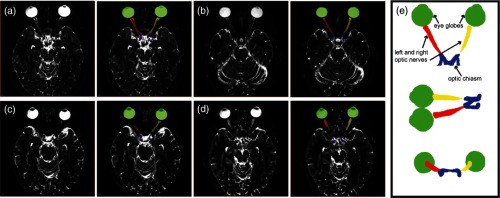Evaluation of Multi-Atlas Label Fusion for Orbital Segmentation on In Vivo MRI
Swetasudha Panda, Andrew J Asman, Shweta P Khare, Lindsey Thompson, Louise A Mawn, Seth A Smith, Bennett A Landman. “Evaluation of Multi-Atlas Label Fusion for Orbital Segmentation on In Vivo MRI.” Journal of Medical Imaging. 1(2), 024002 (Jul–Sep 2014) † PMC4280790
Full Text: https://www.ncbi.nlm.nih.gov/pubmed/25558466
Abstract
Multi-atlas methods have been successful for brain segmentation, but their application to smaller anatomies remains relatively unexplored. We evaluate 7 statistical and voting-based label fusion algorithms (and 6 additional variants) to segment the optic nerves, eye globes and chiasm. For non-local STAPLE, we evaluate different intensity similarity measures (including mean square difference, locally normalized cross correlation, and a hybrid approach). Each algorithm is evaluated in terms of the Dice overlap and symmetric surface distance metrics. Finally, we evaluate refinement of label fusion results using a learning based correction method for consistent bias correction and Markov random field regularization. The multi-atlas labeling pipelines were evaluated on a cohort of 35 subjects including both healthy controls and patients. Across all three structures, NLSS with a mixed weighting type provided the most consistent results; for the optic nerve NLSS resulted in a median Dice similarity coefficient of 0.81, mean surface distance of 0.41 mm and Hausdorff distance 2.18 mm for the optic nerves. Joint label fusion resulted in slightly superior median performance for the optic nerves (0.82, 0.39 mm and 2.15 mm), but slightly worse on the globes. The fully automated multi-atlas labeling approach provides robust segmentations of orbital structures on MRI even in patients for whom significant atrophy (optic nerve head drusen) or inflammation (multiple sclerosis) is present.
